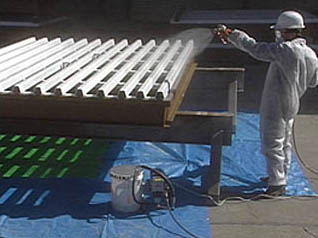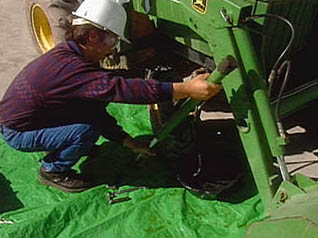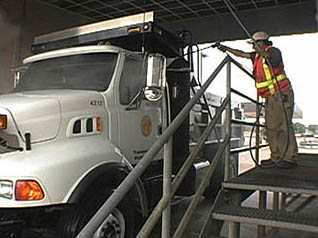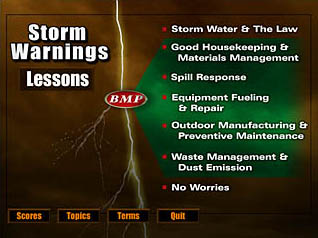Storm Warnings: Storm Water Pollution Prevention
- Product ID
- evisswsp
- Training Time ?
- 54 to 108 minutes
- Language(s)
- English
- Video Format
- Standard Definition
- Required Plugins
- MasteryNet Player
- Lesson Interactions
- 24
- Quiz Questions
- 28
- Closed Captioning



In this stormwater training course your workers will learn how pollution occurs when harmful materials are washed away in water run-off. In this SWPPP training workers will learn how to prevent water pollution and use Best Management Practices when working around water drains. This stormwater training course uses full-motion video to teach workers how to control manufacturing and materials to prevent water pollution. They will learn how to prevent leaks and wastes from leaking into the water supply. In this SWPPP training your workers will learn good waste management practices, proper waste disposal and draining of secondary containment.
![]() This course is in the Advantage™ format, to read about Advantage™ features click here.
This course is in the Advantage™ format, to read about Advantage™ features click here.



- Install on any SCORM LMS
- Rich multimedia presentation with interactions and quiz
- Print certificate and wallet card
- You have 30 days to complete the course
Stormwater training is required for anyone working in an industry handling chemicals, petroleum products, wastes, herbicides, pesticides or other industrial-type materials. This includes workers at government facilities that are covered under a General or Multi-Sector General Permit for storm water discharges, as well as workers at municipal facilities covered under an MS4 Permit.
-
Introduction
- Storm on the way
-
Storm Water & the Law
- The problem
- Storm Water Pollution Prevention Plan
- BMPs
-
Good Housekeeping
- What is good housekeeping?
- Containers & leaks
- Regular clean-up
-
Materials Management
- Loading & unloading
- Outdoor storage
-
Spill Response
- Responsibilities
- Clean-up methods
- Hazardous spills
- Protect storm drains
-
Equipment Fueling & Repair
- Pollutants
- Maintenance guidelines
- Leaking equipment
- Washing
-
Outdoor Manufacturing
- Control manufacturing & materials
- Leaks & wastes
-
Preventive Maintenance
- Scheduled maintenance & regular inspections
-
Waste Management
- Waste & storm drains
- Proper disposal
- Draining secondary containment
-
Dust Emission
- Observation & clean-up
-
Conclusion
- No worries
-
Appraise the severity of water pollution in the US.
- Quantify the level of water pollution in the US.
-
Follow the laws and prescribed mechanisms for prevention.
- Name the plan that governs storm water pollution prevention.
- Identify the class of guidelines for storm water protection.
- List the categories of BMPs.
-
Perform good housekeeping practices.
- List good housekeeping practices.
- Describe the preventive actions in the event of a leak.
-
Take actions to protect materials from exposure to storm water.
- Recall the requirements for temporary protection of materials stored outdoors.
- List characteristics of a proper loading and unloading location.
-
Take proper actions to prevent and clean-up spills.
- Recognize why prompt spill clean up is important.
- Choose the proper measures based on the situation.
-
Be prepared to clean up spills, when it is safe.
- Identify proper methods for spill clean up.
- Locate the tools required.
-
Control materials in vehicle and equipment fueling and maintenance.
- Identify what operations can or cannot be performed outdoors.
- State protective measures required to safely perform maintenance operations outdoors.
-
Prevent exposure of materials used in outdoor manufacturing.
- Name specific protective measures used to control materials.
-
Follow prescribed practices for preventive maintenance.
- Recognize the value of preventive maintenance in SW pollution prevention.
- List preventive measures that contribute to non-polluting equipment.
-
Follow the guidelines for solid waste disposal.
- Describe the allowed wastes and controls for solid waste receptacles.
-
Avoid illicit discharges.
- Identify water operations that are and are not illicit discharges.
-
Follow proper procedures when draining secondary containment.
- Explain the conditions for safely draining secondary containment.
-
Take response actions to control dust emissions.
- State the best action if emissions are observed.
- Name the proper method for clean up of dust accumulations.
-
Follow the principles and practices for storm water protection.
- Recall the basic guidelines for SW pollution prevention.
- Recognize the classes of Best Management Practices.
© Mastery Technologies, Inc.




